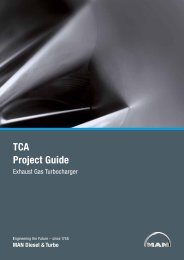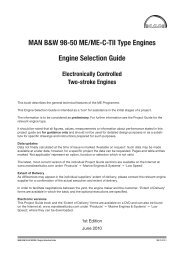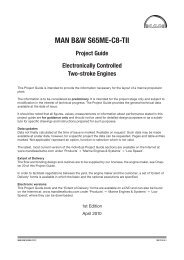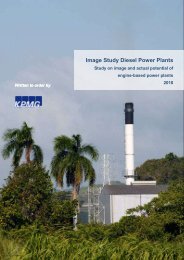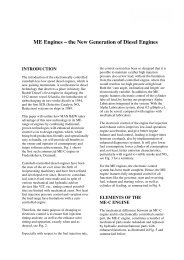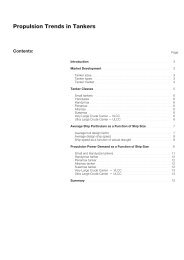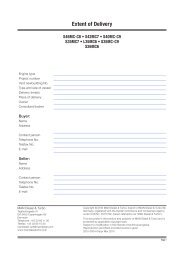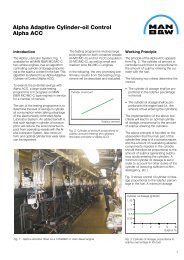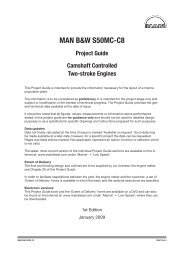This section is available on request - MAN Diesel & Turbo
This section is available on request - MAN Diesel & Turbo
This section is available on request - MAN Diesel & Turbo
Create successful ePaper yourself
Turn your PDF publications into a flip-book with our unique Google optimized e-Paper software.
<strong>MAN</strong> B&W 7.01<br />
Drain of clean fuel oil from HCU, pumps, pipes<br />
The HCU Fuel Oil Pressure Booster has a leakage<br />
drain of clean fuel oil from the umbrella sealing<br />
through ‘AD’ to the fuel oil drain tank.<br />
The flow rate in litres <str<strong>on</strong>g>is</str<strong>on</strong>g> approximately as l<str<strong>on</strong>g>is</str<strong>on</strong>g>ted in<br />
Table 7.01.01.<br />
Engine<br />
Flow rate,<br />
litres/cyl. h.<br />
K98ME/ME-C, S90ME-C<br />
K90ME/ME-C, S/K80ME-C, S70ME-C/<br />
1.25<br />
ME-GI, L70ME-C, S65ME-C/-GI 0.75<br />
S/L60ME-C, S60ME-C-GI 0.60<br />
Table 7.01.01: Approximate flow in HCU leakage drain.<br />
<str<strong>on</strong>g>Th<str<strong>on</strong>g>is</str<strong>on</strong>g></str<strong>on</strong>g> drained clean oil will, of course, influence the<br />
measured SFOC, but the oil <str<strong>on</strong>g>is</str<strong>on</strong>g> not wasted, and the<br />
quantity <str<strong>on</strong>g>is</str<strong>on</strong>g> well within the measuring accuracy of<br />
the flowmeters normally used.<br />
The main purpose of the drain ‘AF’ <str<strong>on</strong>g>is</str<strong>on</strong>g> to collect<br />
pure fuel oil from the fuel pumps as well as the<br />
unintenti<strong>on</strong>al leakage from the high pressure<br />
pipes. The drain oil <str<strong>on</strong>g>is</str<strong>on</strong>g> led to a sludge tank and can<br />
be pumped to the Heavy Fuel Oil service tank or<br />
to the settling tank.<br />
The ‘AF’ drain <str<strong>on</strong>g>is</str<strong>on</strong>g> provided with a box for giving<br />
alarm in case of leakage in a high pressure pipe.<br />
The size of the sludge tank <str<strong>on</strong>g>is</str<strong>on</strong>g> determined <strong>on</strong> the<br />
bas<str<strong>on</strong>g>is</str<strong>on</strong>g> of the draining intervals, the classificati<strong>on</strong><br />
society rules, and <strong>on</strong> whether it may be vented<br />
directly to the engine room.<br />
Drains ‘AD’ and ‘AF’ are shown in Fig. 7.03.01.<br />
Drain of c<strong>on</strong>taminated fuel etc.<br />
Leakage oil, in shape of fuel and lubricating oil<br />
c<strong>on</strong>taminated with water, dirt etc. and collected<br />
by the HCU Base Plate top plate, <str<strong>on</strong>g>is</str<strong>on</strong>g> drained off<br />
through the bedplate drains ‘AE’.<br />
Drain ‘AE’ <str<strong>on</strong>g>is</str<strong>on</strong>g> shown in Fig. 8.07.02.<br />
<strong>MAN</strong> B&W K98ME/ME-C, S90ME-C, K90ME/ME-C,<br />
S80ME-C, K80ME-C, S70ME-C/ME-GI, L70ME-C,<br />
S65ME-C/ME-GI, S60ME-C/ME-GI/ME-B, L60ME-C<br />
<strong>MAN</strong> <strong>Diesel</strong><br />
Heating of fuel drain pipes<br />
Page 3 of 3<br />
Owing to the relatively high v<str<strong>on</strong>g>is</str<strong>on</strong>g>cosity of the heavy<br />
fuel oil, it <str<strong>on</strong>g>is</str<strong>on</strong>g> recommended that the drain pipes<br />
and the fuel oil drain tank are heated to min. 50 °C,<br />
but max. 100 °C.<br />
The drain pipes between engine and tanks can<br />
be heated by the jacket water, as shown in Fig.<br />
7.01.01 ‘Fuel pipe heating’ as flange ‘BD’.<br />
Fuel oil flow velocity and v<str<strong>on</strong>g>is</str<strong>on</strong>g>cosity<br />
For external pipe c<strong>on</strong>necti<strong>on</strong>s, we prescribe the<br />
following maximum flow velocities:<br />
Marine diesel oil .......................................... 1.0 m/s<br />
Heavy fuel oil ............................................... 0.6 m/s<br />
The fuel v<str<strong>on</strong>g>is</str<strong>on</strong>g>cosity <str<strong>on</strong>g>is</str<strong>on</strong>g> influenced by factors such as<br />
emulsificati<strong>on</strong> of water into the fuel for reducing<br />
the NO x em<str<strong>on</strong>g>is</str<strong>on</strong>g>si<strong>on</strong>. <str<strong>on</strong>g>Th<str<strong>on</strong>g>is</str<strong>on</strong>g></str<strong>on</strong>g> <str<strong>on</strong>g>is</str<strong>on</strong>g> further described in Secti<strong>on</strong><br />
7.06.<br />
An emulsificati<strong>on</strong> arrangement for the main engine<br />
<str<strong>on</strong>g>is</str<strong>on</strong>g> described in our publicati<strong>on</strong>:<br />
Exhaust Gas Em<str<strong>on</strong>g>is</str<strong>on</strong>g>si<strong>on</strong> C<strong>on</strong>trol Today and<br />
Tomorrow<br />
Further informati<strong>on</strong> about fuel oil specificati<strong>on</strong>s <str<strong>on</strong>g>is</str<strong>on</strong>g><br />
<str<strong>on</strong>g>available</str<strong>on</strong>g> in our publicati<strong>on</strong>:<br />
Guidelines for Fuels and Lubes Purchasing<br />
The publicati<strong>on</strong>s are <str<strong>on</strong>g>available</str<strong>on</strong>g> at:<br />
www.mandiesel.com under<br />
‘Quicklinks’ → ‘Technical Papers’.<br />
198 76 60�9.0



